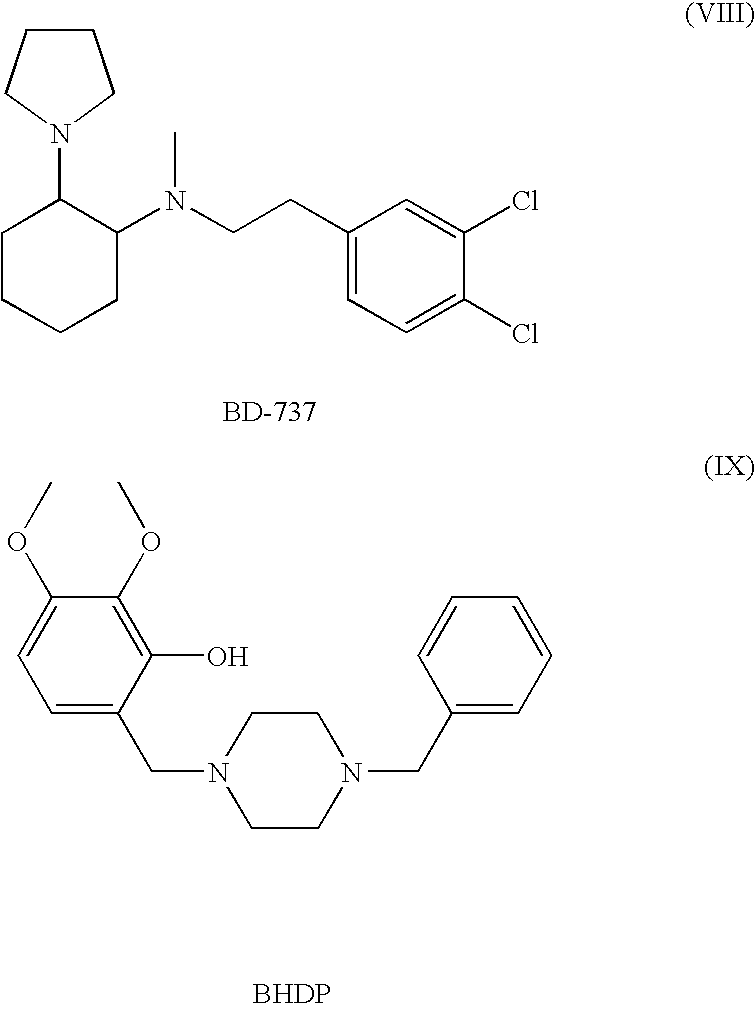Sigma ligands for neuronal regeneration and functional recovery
a neuronal regeneration and functional recovery technology, applied in the field of treatment, can solve problems such as paralysis, speech problems, dementia, etc., and achieve the effect of enhancing functional recovery and neuronal regeneration
- Summary
- Abstract
- Description
- Claims
- Application Information
AI Technical Summary
Benefits of technology
Problems solved by technology
Method used
Image
Examples
example 1
Animal Models for Neuronal Regeneration (Functional Recover)
Male 3 months old SHR (spontaneous hypertensive) rats are used for induction of stroke by MCA occlusion. This is the preferred strain since most stroke patients are hypertensive. The animals are anesthetized with Methohexital and a small craniectomy is made above the zygmotic arch to expose the middle cerebral artery, which is occluded with a 10-0 monofilament nylon thread distal to the origin of the striatal branches. The rats are not intubated and no catheters are inserted. Following MCA occlusion a large and reproducible infarct is obtained, leading to a robust sensorimotor deficit. The animals are kept on a 6 hr light / 18 h dark cycle with free access to food and water. At two days after the MCAO the rats are treated with the compound I, II, III, IV, V, VI, VII, VIII, or IX (0.03-10 mg / kg) s.c. or p.o. and a control group is given saline for 2-8 weeks. At 2, 4, 6 and 8 weeks animals are tested in the rotating pole or ...
example 2
Evidence of Neuronal Regeneration in Rats Treated with SA4503
1. Rotating Pole
Thirty five spontaneously hypertensive rats were exposed to permanent middle artery occlusion (MCAO), then divided into three treatment groups. Starting at two days after occlusion and continuing daily until 28 days after occlusion, SA4503 was administered s.c. in doses of 0.3 mg / kg (12 rats) or 1.0 mg / kg (12 rats). In a control group (11 rats), vehicle only was administered. At the start of treatment, and at several time points during the test, the rats were assessed for their performance in the rotating pole model. This model is described in Example 1. It requires the rats to cross a horizontally suspended rotating pole having a length of 1 m. This task measures the sensory-motor performance of the animals. The animals' behaviour was recorded using a video camera and later analyzed and scored by a trained technician. The scoring ranges from 0 to 6, with 0 being very poor performance and 6 reflecting t...
example 3
Evidence of Neuronal Regeneration in Rats Treated with Siramesine
1. Morris Water Maze
The Morris water maze was used to assess functional recovery, in-particular recovery in a cognitive skill, in spontaneously hypertensive rats after exposure to permanent middle artery occlusion (MCAO), a model of ischemic stroke.
Forty three spontaneously hypertensive rats were exposed to permanent middle artery occlusion (MCAO). Starting at two days after occlusion and continuing for 14 days, Siramesine was administered p.o. in doses of 0.3 mg / kg (14 rats) or 1.0 mg / kg (14 rats). In a control group (15 rats), vehicle only was administered. On day 35 after permanent MCAO, the rats were assessed for their performance in the Morris Water Maze Test.
In the test, the rats were given a series of 6 trials, 1 hour apart in a large dark-colored tank (200 cm in diameter) filled with clear water at a temperature of 22.0±1.5° C. A 12×12-cm submerged platform (2 mm below the water surface) was placed in t...
PUM
| Property | Measurement | Unit |
|---|---|---|
| Time | aaaaa | aaaaa |
| Time | aaaaa | aaaaa |
| Time | aaaaa | aaaaa |
Abstract
Description
Claims
Application Information
 Login to View More
Login to View More - R&D
- Intellectual Property
- Life Sciences
- Materials
- Tech Scout
- Unparalleled Data Quality
- Higher Quality Content
- 60% Fewer Hallucinations
Browse by: Latest US Patents, China's latest patents, Technical Efficacy Thesaurus, Application Domain, Technology Topic, Popular Technical Reports.
© 2025 PatSnap. All rights reserved.Legal|Privacy policy|Modern Slavery Act Transparency Statement|Sitemap|About US| Contact US: help@patsnap.com


